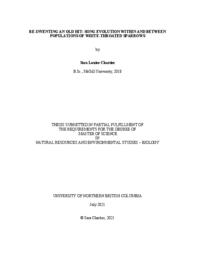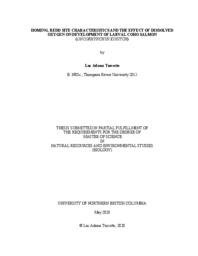University of Northern British Columbia. NRES-Biology
Related Works
Content type
Digital Document
Description / Synopsis
My thesis investigates how urban noise influences the relative audibility of songs to female Mountain Chickadees (Poecile gambeli), who assess male signalling at dawn while roosting within the nest cavity. Over two breeding seasons, I monitored Mountain Chickadees breeding on an urban/rural interface in Kamloops, BC, Canada. I broadcast typical Mountain Chickadee songs, with or without added noise, towards recently unoccupied nests while simultaneously re-recording these songs with microphones outside and inside the nest box to determine the relative audibility in relation to both distance and presence/absence of noise. I then tracked individual males’ behaviour and movement during dawn signalling, while passively recording their songs with microphones — outside and inside the nest box — to determine the relative audibility of signals from the perspective of the roosting female. The relative audibility of songs decreased with increasing distance from the nest, which was compounded by increased urban noise. During dawn signalling, urban males respond to these effects by remaining closer to the nest, resulting in their songs being more audible within the nest than their rural counterparts. Overall, ambient noise and distance had an interactive effect on relative audibility of songs, suggesting complex dynamics of communication networks that may result in a trade-off, where males are forced to prioritize directing their signals to either their social mates or neighbours.
Origin Information
Content type
Digital Document
Description / Synopsis
Kokanee, the non-anadromous life history form of Oncorhynchus nerka, use lacustrine habitat in watersheds draining into the north Pacific Ocean. Kokanee have also been widely introduced into reservoirs following impoundment of rivers due to the construction of dams. Locally-adapted subpopulations of Kokanee, however, should be identified and evaluated when implementing watershed-level management strategies. In Chapter 1, I examined fork length, condition factor, and age at maturity for Kokanee in the Williston watershed of northern British Columbia to identify potential spatial and temporal trends in demographic structure following a large-scale stocking program that occurred in the 1990s. Adult spawning Kokanee that were native to the reservoir and collected prior to stocking events were significantly larger and maintained higher condition factors than Kokanee stocked from the Columbia River sampled in any year after 1991. Introduced Kokanee sampled in 2018 and 2019 were the smallest spawners and were significantly smaller than all fish collected between 1989 and 2018; the condition factors of these fish were also significantly lower than native Kokanee and the first spawning cohorts of Columbia-origin fish. The average age at maturity did not change across spatial or temporal scales (3 yrs.). My results indicate an ongoing trend of decreasing spawner size and condition factor for Kokanee in the Williston Reservoir since introduction events in the early 1990s. In Chapter 2, I analyzed the genetic population structure of Kokanee in the Williston watershed, including from the reservoir before stocking Columbia-origin fish and native populations from headwaters of the Williston Reservoir: Thutade, Arctic, and Tacheeda Lakes. Using microsatellite markers, I identified that all fish collected from 2006 to 2019 were introduced Columbia-origin genotypes, and there was no evidence of genetic divergence by spawning location. Native populations in Arctic and Tacheeda Lakes remained entirely separate from the reservoir populations, and there was no indication of past or current introgression with introduced stock. I identified that native Williston Reservoir Kokanee diverged from the Thutade Lake population; as native Williston fish have not been sampled since 2000, it is likely that this population has been extirpated in the reservoir by the successful Columbia-origin lineage. My results highlight an unfortunate consequence of underinformed management practices that failed to recognize the native Williston Kokanee as a distinct population. Strategies that incorporate knowledge of subpopulations of Williston watershed Kokanee, such as genetic populations or reproductive ecotypes, should be prioritized to conserve locally-adapted genetic diversity.
Origin Information
Content type
Digital Document
Description / Synopsis
Cultural evolution of birdsong occurs when songs change over generations and such changes can spread directionally or via drift within and between populations. The objective of this thesis was to document the emergence and spread of a novel song variant, the Modulated-Doublet, within and between populations of White-throated Sparrows. I analysed songs recorded in a Prince George population between 2015-2020 to document song shift within the population. I also analysed songs from public song archives to document song transition on a continental-scale between 2014-2020. I found the Modulated-Doublet started as a rare variant but became the predominant variant within our population over a very short time. At the continental scale, the Modulated-Doublet emerged simultaneously and spread synchronously in multiple breeding populations and migratory routes, replacing the previous variant in those populations. This rapid spread at both scales suggests it is driven by several transmission biases; however further investigation is needed to determine their nature.
Origin Information
Content type
Digital Document
Origin Information
Content type
Digital Document
Description / Synopsis
Life histories of Pacific salmon are remarkable in that they return to specific freshwater sites to spawn after multiple years of ocean residence. In Chapter 1, I investigated site fidelity at a reach scale for Interior Fraser Coho Salmon (Oncorhynchus kisutch) (IFC). Coho Salmon eggs were incubated at known spawning locations in the Coldwater River, British Columbia, to obtain reference data for comparison to otolith signatures of returning adult salmon. The majority of adults (67%) returned to their natal spawning locations at the reach scale, while 33% strayed to other spawning sites within the Coldwater River, illustrating straying at small scales. Straying to novel incubation sites at the reach scale demonstrated plasticity in homing within a watershed. In Chapter 2, I investigated the characteristics of the hyporheic redd zone over two years where Coho Salmon were observed to spawn. Within a reach, physical variables were homogenous, but heterogeneity was found among reaches where Coho Salmon were observed to spawn – particularly for intragravel temperature and dissolved oxygen. The difference in temperature and dissolved oxygen among sites had a pronounced effect on survival, rate of development, and emergence time for Coho Salmon fry. Heterogeneity among spawning locations demonstrate trade-offs that exist between rate of development and survival. Chapter 3 investigated the effect of low and variable dissolved oxygen on developing salmon embryos. A family effect was found as smaller eggs produced smaller alevin, but the effect of low dissolved oxygen on growth was also greater for the families with small eggs. Treatment affected rate of development and initially had an effect on length and mass, but by button-up there was no longer an effect of low dissolved oxygen on size. My work demonstrates plasticity in Coho Salmon at different life stages. Plasticity is important for utilizing new habitats or adapting to existing habitats as they change.
Origin Information
Content type
Digital Document
Description / Synopsis
Understanding the mountain pine beetle detoxification systems is vital for predicting its continued spread into the novel jack pine host. Phylogenetic analyses were conducted for mountain pine beetle catalase, glutathione peroxidase, superoxide dismutase, and peroxiredoxin. These proteins were generally conserved, but there were differences in some key functional motifs. Specifically, a peroxiredoxin (DPPrx1) contained a unique combination of hyperoxidation motifs. DPPrx1 and a superoxide dismutase (DPSOD1) were selected for further functional analyses and demonstrated higher reactivity when compared to other SOD and Prx proteins. Also, DPPrx1 experiences hyperoxidation at a lower H2O2 concentration (~0.06 mM) than human peroxiredoxin (~0.12 mM). In other systems, hyperoxidized peroxiredoxin does act as a signal molecule for the expression of other oxidative stress proteins. Therefore, due to its relatively high reactivity and potential role as a cellular signal, DPPrx1 could serve as a future pest management target.
Origin Information






